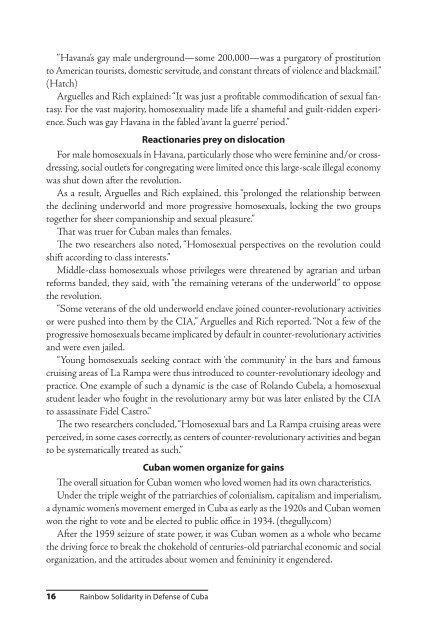LavenderRed_Cubabook
LavenderRed_Cubabook
LavenderRed_Cubabook
Create successful ePaper yourself
Turn your PDF publications into a flip-book with our unique Google optimized e-Paper software.
“Havana’s gay male underground—some 200,000—was a purgatory of prostitution<br />
to American tourists, domestic servitude, and constant threats of violence and blackmail.”<br />
(Hatch)<br />
Arguelles and Rich explained: “It was just a profitable commodification of sexual fantasy.<br />
For the vast majority, homosexuality made life a shameful and guilt-ridden experience.<br />
Such was gay Havana in the fabled ‘avant la guerre’ period.”<br />
Reactionaries prey on dislocation<br />
For male homosexuals in Havana, particularly those who were feminine and/or crossdressing,<br />
social outlets for congregating were limited once this large-scale illegal economy<br />
was shut down after the revolution.<br />
As a result, Arguelles and Rich explained, this “prolonged the relationship between<br />
the declining underworld and more progressive homosexuals, locking the two groups<br />
together for sheer companionship and sexual pleasure.”<br />
That was truer for Cuban males than females.<br />
The two researchers also noted, “Homosexual perspectives on the revolution could<br />
shift according to class interests.”<br />
Middle-class homosexuals whose privileges were threatened by agrarian and urban<br />
reforms banded, they said, with “the remaining veterans of the underworld” to oppose<br />
the revolution.<br />
“Some veterans of the old underworld enclave joined counter-revolutionary activities<br />
or were pushed into them by the CIA,” Arguelles and Rich reported. “Not a few of the<br />
progressive homosexuals became implicated by default in counter-revolutionary activities<br />
and were even jailed.<br />
“Young homosexuals seeking contact with ‘the community’ in the bars and famous<br />
cruising areas of La Rampa were thus introduced to counter-revolutionary ideology and<br />
practice. One example of such a dynamic is the case of Rolando Cubela, a homosexual<br />
student leader who fought in the revolutionary army but was later enlisted by the CIA<br />
to assassinate Fidel Castro.”<br />
The two researchers concluded, “Homosexual bars and La Rampa cruising areas were<br />
perceived, in some cases correctly, as centers of counter-revolutionary activities and began<br />
to be systematically treated as such.”<br />
Cuban women organize for gains<br />
The overall situation for Cuban women who loved women had its own characteristics.<br />
Under the triple weight of the patriarchies of colonialism, capitalism and imperialism,<br />
a dynamic women’s movement emerged in Cuba as early as the 1920s and Cuban women<br />
won the right to vote and be elected to public office in 1934. (thegully.com)<br />
After the 1959 seizure of state power, it was Cuban women as a whole who became<br />
the driving force to break the chokehold of centuries-old patriarchal economic and social<br />
organization, and the attitudes about women and femininity it engendered.<br />
16 Rainbow Solidarity in Defense of Cuba


